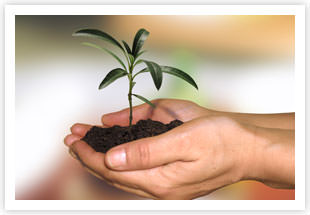|
Home Kids Center Steps to Go Green Green at Work Green at Home Recycling Events About Us Contact Us |
||
 |
|
|
|
|
|
Steps to Go Green1. ENGINES OFFIt’s a popular misconception that leaving your car’s engine idle a few minutes saves more energy than turning it off and on when you need it. Turn your car’s engine off even if you are thinking about leaving it idle for over 30 seconds waiting to pick up kids from school or other short stops. By idling your car 10 minutes LESS per day, you can keep 550 pounds of carbon dioxide out of the air every year. 2. ONE CUP A DAYEvery morning, each member of your family should start out with one cup, which they use all day. This helps them cut down on dirty dishes and reduces the number of times they need to run the dishwasher each week. 3. ONE NAPKIN CAN SAVE BILLIONS OF PAPER WASTEElizabeth Rogers is a working mother who is passionate about our environment. She transformed that passion into The Green Book, a collection of 500 "little things that make a big difference" in changing the environment, Elizabeth says. (Coming June 2007.) One of the simple things that you can do is to reduce your use of paper napkins…by just one a day! "Napkins make a huge difference," Elizabeth says. "We use 2,200 of them a year, per person on average. Six a day. So if we all gave up one napkin a day, we could save a billion pounds of paper waste … from going to landfills a year." 4. ATM RECEIPTSElizabeth says there's an important way you can go green when you're getting the green. Receipts from 8 billion ATM transactions every year are one of the biggest sources of litter on the planet. "If everyone left their receipts in the machine, it would save a roll of paper more than 2 billion feet long—enough to circle the equator more than 15 times," she says.* 5. PLANT A TREEThe average person is responsible for emitting 94 pounds of carbon dioxide every day. It takes four trees, which act as natural air filters, to offset the carbon dioxide each person generates in a month. Check with local nurseries and plant trees where you can here in Stockton. You can also donate online and for each dollar donated, AmericanForests.org plants a tree.* 6. PAPER OR PLASTIC?More than 380 million plastic bags are thrown away in the United States every year, and those plastic bags can take up to 1,000 years to biodegrade in landfills. And while paper bags do eventually biodegrade, an estimated 14 million trees a year have to be cut down to make 10 billion paper bags. The solution? Bring your own 100% cotton tote bags to the store. 7. VAMPIRE ELECTRICITY DRAINMost people don't know that plugged-in appliances and electronics use energy even if they're turned off. Simran Sehti hosts The Green on the Sundance Channel and says, "We're spending all this money to power things that are in the off position. We call it vampire standby power." To cut your electricity costs, Simran suggests plugging in your electronics to the Smart Power Strip, which retails for $32.95. Then, when you turn off the power strip, all the items plugged into it will also power down. Over time, you'll see your monthly electricity bill and your energy usage decrease. 8. BUYING ONE LITER OF WATER USES FIVE LITERS TO PRODUCEWhen you buy one liter of water at the store, you're actually buying about six liters of water, Simran says. That's because when manufacturers make plastic bottles, it takes five liters of water to cool the plastic. To save the resources used in creating all those bottles, get a water filter and a reusable aluminum or plastic bottle and refill your own. One thing to consider if you buy a plastic bottle is its grade. Look on the bottom of the bottle for a small plastic triangle with a number in the middle. If you see a number 2, 4 or 5, the bottle is safe. If it has some other number, don't use it as a water bottle. Those other plastics can make your water taste like plastic and leach harmful chemicals into your body. 9. LIGHTING THE WAY EFFICIENTLYNot so long ago, Americans lit their homes with candles. Thanks to modern technology, you can be almost as environmentally friendly without burning down the house. If every family replaced one bulb with a CFL, Simran says it would be like reducing carbon emissions from 800,000 cars. "I'm asking [America] to have a lightbulb moment and change out one lightbulb!" she says. Replacing regular, inefficient lightbulbs with compact florescent lighbulbs (CFLs) can make a big difference. "Most of the energy in the United States comes from coal-fired plants," she says. "What we're doing when we run inefficient products is we're burning a lot more coal, and we're putting a lot more carbon into the environment." A CFL is 70 to 75 percent more efficient than other bulbs, she says. Florescent bulbs will cost a little more up front, but Simran says you should save money on your electricity bill over time. Plus, these bulbs can last 8 to 10 years! 10. DONATE (RECYCLE) ITEMS TO LOCAL CHARITIESWhy fill our landfills with items that others can use. For example, some have said that it takes 50 years to break down old leather shoes in a landfill. Wouldn’t those shoes be put to better use by sharing them with those in need? You bet. The same goes for furniture and other household items that you are no longer using. The Goodwill, Salvation Army, American Cancer Society and others all accept "recycled" items. |
 Helpful checklist...Clip this list and put on your refrigerator as a friendly reminder of easy ideas that you and your family can do to make a big difference.
|
||